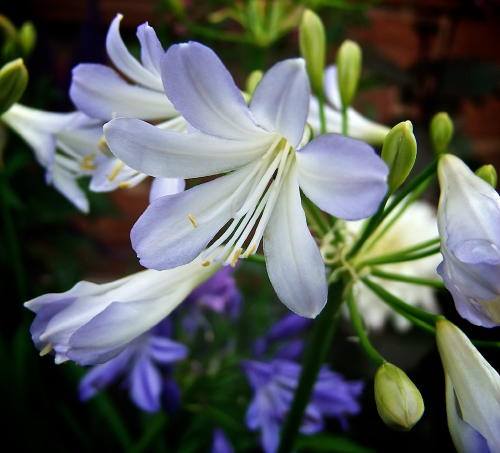Understanding the Art of Agapanthus Treatment: Crucial Steps for Healthy And Balanced Growth and Vibrant Blooms
In the realm of cultivation, the cultivation of agapanthus stands as a gratifying undertaking for those who look for to support these sophisticated flowering plants. From choosing the appropriate variety to grasping pruning strategies, the trip towards cultivating growing agapanthus plants is complex and holds the vital to opening the complete potential of these organic treasures.

Picking the Right Agapanthus Range

When picking the right Agapanthus selection for your yard, think about factors such as environment suitability, bloom color, and development behavior. Agapanthus, commonly called Lily of the Nile or African lily, can be found in a range of shades varying from shades of blue and purple to white. Choose a blossom color that enhances your existing yard scheme to develop an unified landscape. Furthermore, consider the environment in your area to make sure the Agapanthus selection you select can thrive in your specific conditions. Some ranges are more tolerant of cool temperature levels, while others favor warmer climates. Understanding the growth routine of different Agapanthus ranges is critical for correct placement within your yard. Some varieties have a clumping development behavior, suitable for boundaries or containers, while others have a more spreading nature, suitable for ground cover or mass plantings. By carefully reviewing these variables, you can select the best Agapanthus variety to improve the charm of your yard.
Suitable Growing Conditions
Considering the ideal ecological requirements is necessary for effective Agapanthus cultivation. Agapanthus plants are sensitive to cool temperature levels and should be shielded from frost throughout winter months.
To make certain healthy development and vivid flowers, plant Agapanthus bulbs at a deepness of about 2-4 inches and room them 8-12 inches apart. Mulching around the base of the plants aids maintain wetness and subdues weed development.
Watering and Fertilizing Tips
Keeping appropriate dampness levels and giving vital nutrients are key aspects in the treatment program for Agapanthus plants. When it comes to sprinkling Agapanthus, it is essential to strike an equilibrium. These plants like regularly wet dirt however are at risk to root rot if overwatered.
Fertilizing Agapanthus is necessary for promoting healthy development and respected blossoms. Use a well balanced fertilizer, such as a 10-10-10 formula, in the very early springtime as brand-new development arises. Repeat this application every 6-8 weeks throughout the growing period. Avoid extreme fertilizing, as it can bring about lush vegetation at the expenditure of flowers. Constantly adhere to the producer's instructions for proper dilution and application methods. By following these watering and fertilizing suggestions, you can ensure your Agapanthus plants flourish and create lively, durable blossoms.
Trimming Methods for Agapanthus
Trimming Agapanthus plants at the ideal times and with correct strategies is vital for preserving their health and advertising ideal growth and blooming. The ideal time to trim Agapanthus is in late wintertime or early springtime before new growth emerges.
For flowered stems, wait till the blooms have actually withered and after that trim them back to the base. This not just cleans the plant's look but additionally urges the advancement of brand-new blossom buds. Deadheading spent blossoms can likewise click here to read reroute the plant's energy right into creating more blossoms rather than establishing seeds. Nevertheless, if you wish to accumulate seeds for proliferation, leave some flowers to dry and mature on the plant.
Bear in mind to utilize tidy, sharp tools to make precise cuts and reduce the risk of presenting diseases. Agapanthus. Routine trimming will certainly aid keep your Agapanthus looking neat and healthy while making sure a plentiful screen of beautiful blossoms
Dealing With Usual Insects and Conditions
After ensuring proper pruning methods for Agapanthus, it is important to attend to usual insects and illness that can impact the health and vitality of these plants. One common pest that influences Agapanthus official source is the Agapanthus gall midget.
One more typical problem is fungal leaf area, which offers as dark sores on the fallen leaves. To stop fungal illness, make sure good air circulation around the plants, avoid above watering, and eliminate any infected fallen leaves promptly. In addition, Agapanthus plants can experience from root rot if they are grown in improperly draining dirt. To prevent this, plant Agapanthus in well-draining dirt and stay clear of overwatering. By being vigilant and taking punctual activity against illness and pests, you can assist your Agapanthus plants grow and produce vibrant blossoms.

Final Thought
In final thought, grasping the art of agapanthus care involves picking the right variety, supplying ideal planting conditions, why not look here appropriate watering and feeding, proper trimming strategies, and addressing typical bugs and conditions. By adhering to these important steps, you can guarantee healthy and balanced development and vivid blossoms for your agapanthus plants. Remember to frequently keep an eye on and preserve your plants to advertise their total health and long life.
To make certain healthy development and vibrant flowers, plant Agapanthus light bulbs at a depth of concerning 2-4 inches and area them 8-12 inches apart. By complying with these watering and feeding ideas, you can ensure your Agapanthus plants thrive and generate vibrant, lasting blooms.
One common pest that affects Agapanthus is the Agapanthus gall midge. In addition, Agapanthus plants can endure from root rot if they are grown in badly draining soil. By complying with these crucial actions, you can ensure healthy and balanced development and lively flowers for your agapanthus plants.